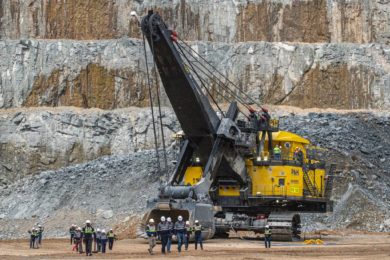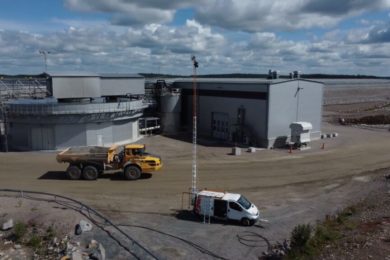Weba Chute Systems, known for challenging the boundaries in transfer point technology, has leveraged its in-depth applications knowledge and know-how to engineer an innovative bifurcated chute system for Eldorado Gold’s Skouries project. The bifurcated chute is one of nine transfer point solutions that are being engineered and manufactured by Weba Chute Systems for the Hellas Gold Skouries project. This high-grade gold-copper porphyry deposit is located in the Halkidiki Peninsula in northern Greece, and will operate as an open pit mine for around seven years followed by a further 20 years of underground development.
Alwin Nienaber, Technical Director at Weba Chute Systems, says this is not the first time the leading manufacturer of transfer point solutions has worked with Eldorado Gold. Previous successes have included custom engineered chute systems for the mining house’s Tuprag Kisladag operation in Turkey.
An important contributing factor to this particular project was the extensive communication between the mine, the EPCM contractor and Weba Chute Systems which resulted in Weba being able to assess, adjust and verify general arrangements between conveying, crushing and screening equipment. “As a result of this, we were able to engineer chute solutions with the correct performance characteristics that will deliver the required throughput,” Nienaber says.
Commenting on the design of the bifurcated transfer point, Nienaber explains that this particular chute is engineered for the secondary crushing circuit. The chute feeds either a surge bin, which in turn feeds the secondary crushers, or it provides a facility whereby the crushers are bypassed.
Among the challenges in this particular application was having to overcome a transfer height of 17.5 m by passing from just below the head pulley through the conveyor building, then under the structure, over the bin and down to the conveyor, and still provide access for crusher maintenance.
An additional challenge with the transfer point was that this particular bypass leg’s only function is to allow for the removal of mill balls and occasional tramp iron.
Design Draughtsman at Weba Chute Systems, Wesley Hunkin, explains that the conveyor which feeds the chute is equipped with a metal detection device located approximately 30 m behind the head pulley. “One of the challenges was to provide a reliable solution that would ensure iron balls or tramp iron would report to the correct chute leg, thereby eliminating any possibility of this reporting to the crushers,” he says.
“An innovative articulating trolley chute section was incorporated in this transfer point to redirect the portion of product containing iron balls and tramp iron into the bypass leg,” Hunkin says. “The velocity of this trolley section was also crucial in order to reduce the additional volume that would be added to the recirculating load.”
Six of the chutes, out of the total order for nine, will be installed on the primary crushing circuit; four of which are apron feeder discharge chutes and have been designed for material feed rates varying from 1,200 t/h up to 1,598 t/h with a max lump size of minus 300 mm.
The other two chute systems to be installed in the primary crushing circuit are a primary crusher sacrificial conveyor discharge chute and an ore reclaim sacrificial conveyor discharge chute. The former is designed for a material throughput rate of 1,598 t/h and the latter 1,197 t/h; both transferring minus 300 mm material loading onto belts with a width of 1,372 mm.
Apart from the innovative bifurcating chute system, two others will be installed in the secondary crushing and pebble bypass circuit.
The first of these is a SAG mill screen oversize chute designed for a feed rate of 611 t/h with a maximum lump size of 75 mm. This transfer point is another example of where Weba used its extensive experience and provided an innovative solution that will eliminate direct belt impact.
“This was done by splitting the chute into two, thereby avoiding direct belt impact. By doing this, we have been able to preserve belt presentation meaning not only a reduction in impact but also reduced dust and noise, and less wear on the belt,” Nienaber says. “Another advantage will be improved idler life and the belt will be running true.”
“Had a conventionally designed chute been installed at this challenging transfer point, material presentation onto the conveyor belt would have been at high impact with a marked tendency for skew belt loading,” he adds.
The last of the chutes in this section of the plant is a bypass circuit conveyor chute that feeds back onto the SAG mill conveyor. This is approximately a 45 degree chute reversing back on itself, and changing direction three times on itself over a height of 4 m.
“This type of custom engineered solution was essential as a conventional chute would have a hard time presenting material back onto a conveyor under these conditions,” Nienaber says.
Other significant advantages that Weba Chute Systems brings to bear on projects are the company’s flexibility, agility and commitment to meeting the project deadline. Nienaber explains that a portion of these Weba Chute Systems were manufactured in Turkey. “This enabled us to shorten the lead time and in so doing meet the requisite time frame for delivery,” he says.
“Providing solutions to such challenging applications is not always as straightforward as it would seem, and it is through leveraging our more than 26 years of experience and applications knowledge that we are able to partner with companies across the globe to meet their exacting materials transfer needs,” Nienaber concludes.










